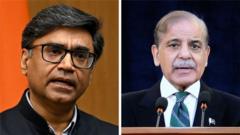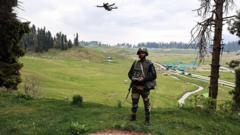India and Pakistan have announced a cease-fire after four days of extensive fighting, the most severe in decades. While there is celebratory sentiment surrounding the truce, reports indicate ongoing clashes along the border, particularly in the contested Kashmir region.
India-Pakistan Cease-Fire Announced Amid Continued Tensions

India-Pakistan Cease-Fire Announced Amid Continued Tensions
Following a period of intense conflict between India and Pakistan, a cease-fire has been declared, though violence persists in some regions.
The cease-fire between India and Pakistan was announced on May 10, 2025, following some of the most intense fighting the region has seen in decades, with drone strikes and missile exchanges prevalent. The declaration was confirmed by India's foreign secretary, Vikram Misri, amidst an atmosphere of cautious optimism and concerns about potential violations.
While citizens in both nations celebrated the truce, there were reports of ongoing hostilities, particularly in Jammu and Kashmir, highlighting the fragility of the cease-fire. President Trump announced the cease-fire on social media, attributing its existence to U.S. mediation efforts, a claim supported more fully by Pakistan than India.
Pakistani Prime Minister Shehbaz Sharif expressed gratitude for the U.S. involvement, stating the agreement was essential for regional peace. However, as night fell, reports emerged of continued gunfire and drone activity across the Line of Control, suggesting that the cease-fire's effectiveness may be in jeopardy.
The latest military escalations began following a militant attack in Indian-administered Kashmir last month, which India attributed to Pakistani support. In a bid to counter perceived threats, India launched a series of airstrikes targeting militant bases in Pakistan. But the fallout of intensified military operations left both nations assessing the resulting damage and its long-term implications on regional stability.
Global reactions have ranged from relief to calls for sustained peace, with various countries urging restraint on both sides. The conflict has drawn particular concern due to the extensive use of drones, which represents a new and disturbing phase of warfare in the region. Both countries have been developing their drone capabilities, and the latest skirmishes highlight the changing nature of conflict in South Asia.
The international community is closely monitoring the situation, and moving forward, both nations will likely need to address their diplomatic relationships and the underlying issues fueling conflict to ensure that the cease-fire holds and set the stage for constructive dialogue.
While citizens in both nations celebrated the truce, there were reports of ongoing hostilities, particularly in Jammu and Kashmir, highlighting the fragility of the cease-fire. President Trump announced the cease-fire on social media, attributing its existence to U.S. mediation efforts, a claim supported more fully by Pakistan than India.
Pakistani Prime Minister Shehbaz Sharif expressed gratitude for the U.S. involvement, stating the agreement was essential for regional peace. However, as night fell, reports emerged of continued gunfire and drone activity across the Line of Control, suggesting that the cease-fire's effectiveness may be in jeopardy.
The latest military escalations began following a militant attack in Indian-administered Kashmir last month, which India attributed to Pakistani support. In a bid to counter perceived threats, India launched a series of airstrikes targeting militant bases in Pakistan. But the fallout of intensified military operations left both nations assessing the resulting damage and its long-term implications on regional stability.
Global reactions have ranged from relief to calls for sustained peace, with various countries urging restraint on both sides. The conflict has drawn particular concern due to the extensive use of drones, which represents a new and disturbing phase of warfare in the region. Both countries have been developing their drone capabilities, and the latest skirmishes highlight the changing nature of conflict in South Asia.
The international community is closely monitoring the situation, and moving forward, both nations will likely need to address their diplomatic relationships and the underlying issues fueling conflict to ensure that the cease-fire holds and set the stage for constructive dialogue.






















